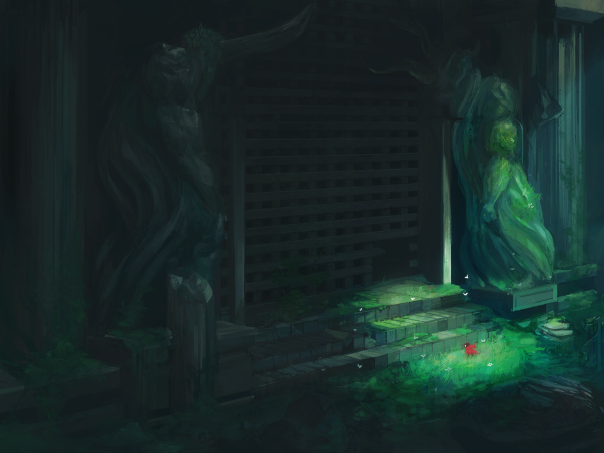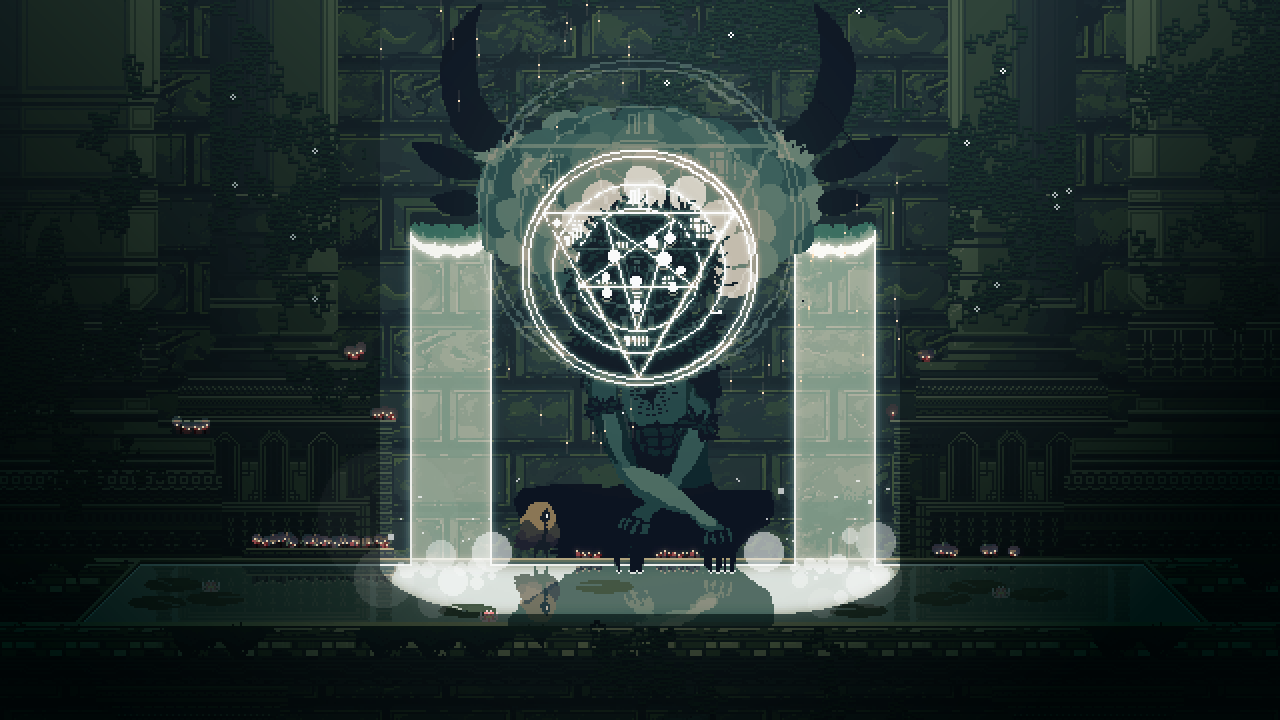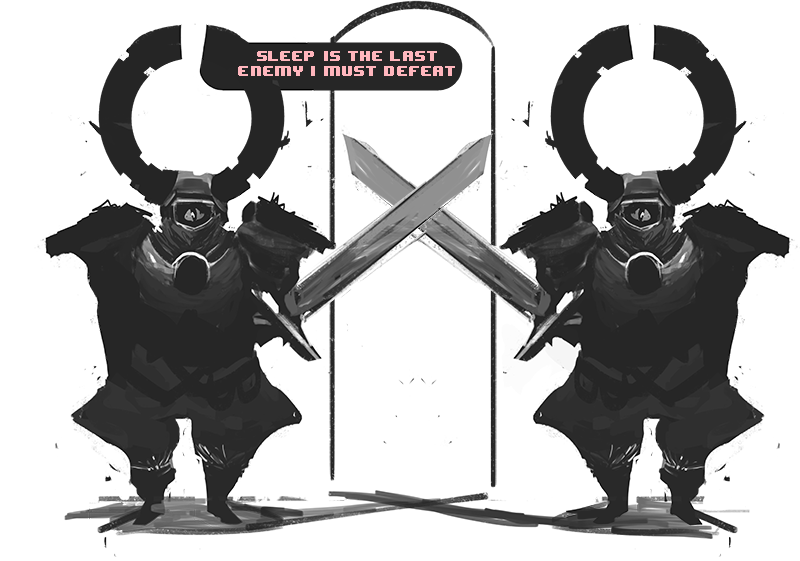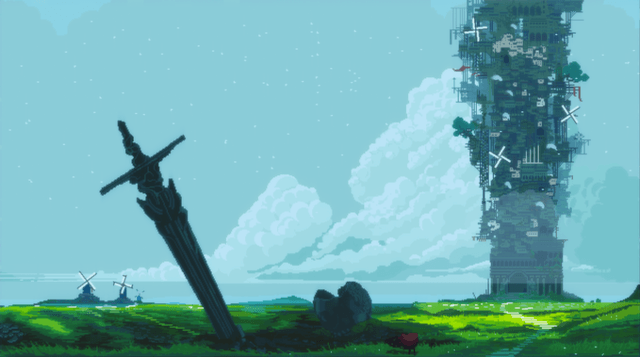After its initial Kickstarter launch on October 20th, backers flocked to Doko Roko to throw their support behind the 2D rogue-like vertical ascension video game. Eric Mack, the creator behind the game, witnessed the fantastic and humbling moment when Doko Roko met its $30,000 funding goal eleven days into the campaign. To follow up on this excitement, Mack agreed to let us pick his brain as we attempted to gather further insight into his promising project.
Kickstarter success
In just two days of its Kickstarter launch, Doko Roko met 33% of its funding goal. By the eighth day, this had jumped to 66.6% of the total goal, with the added bonus of being selected as a staff pick on the host site. On November 1st, Mack noted that the project had attracted over 1,000 backers. The good news just kept on coming when Steam officially Greenlit Doko Roko. This means that thousands of players said they would buy the game if it was offered on Steam.
 Mack’s celebratory T-shirt design sketch.
Mack’s celebratory T-shirt design sketch.
A brief introduction to Doko Roko
For all the information officially released by Mack as well as a taste of his creative sense of storytelling, you can check out Doko Roko‘s Kickstarter page. For those eager to get to the juicy interview bits, I’ll provide a quick summary of the project, adding pertinent details throughout the interview as well.
“A symbiosis with ancient shadows. A tower full of demons. A proverb.”
As mentioned above, Doko Roko falls into Mack’s experimental category of a 2D rogue-like vertical ascension game. The gameplay emphasizes “lightning-fast combat and a rich atmosphere.”
Doko Roko‘s protagonist, the Unslain, utilizes magick and a hefty sword throughout the adventure. The Unslain will encounter the inhabitants of the strange Tower along the way, from lonely folk to aggressive monsters.
 This old man may be a strange combination of lonely folk and monster.
This old man may be a strange combination of lonely folk and monster.
Let’s journey into the mind of Eric Mack, shall we?
After improving his art via Noah Bradley’s 12 week Art Camp and learning to code in Java, Mack decided he wanted to be more than a concept artist. His dream evolved to making video games.
Aside from a handful of prototypes, Doko Roko will be Mack’s first fully-fledged video game. His passion drives him to see this project through and garners his full commitment. Given Mack’s dedication to this project, we dug into his sources of inspiration in order to get a solid look into the mind of the creator while uncovering hints at what his game has in store for players.

Gabriella Graham: You’ve been gaming such a long time (“pre-pre-school,” you’ve said). So let’s start with the basics: What games were your favorites growing up and when did you first realize you wanted to pursue a career in video games?
Eric Mack (EM): I think some of the first games that I played were actually on my dad’s gateway computer that had Windows 98 installed. He installed a bunch of games on it but the only ones I remember are this really gross looking Pac-Man clone as well as this crazy technical flight simulator with these vector graphics. I think I liked those a lot, but I think I had a much better video game experience when I’d go over my grandpa’s house.
My grandpa used to be pretty much obsessed with sudoku and crossword puzzles. I’d see them littered all over the house all filled in. Him buying a Nintendo entertainment system seemed like the next logical step in this sequence of mental challenges. He literally had like 3 huge plastic containers filled with cartridges and it seemed like he actually played them a lot as I’d see maps that he’d drawn on graph paper as well as passwords and different little secret notes. I think I naturally gravitated toward a lot of the classics. I liked Super Mario Bros as well as Metroid. The first time he told me to go backwards in Metroid I think the top of my head blew off. Megaman X was another big one that I’d play a lot when I got a SNES.
I think I realized I wanted to pursue a career in videogames around middle school. I had no idea what that meant really. My 6th grade science teacher had just given us an assignment one day that was essentially writing out the history of our lives as if we were dead and I wrote that I wanted to work for Naughty Dog.

GG: After reading your Kickstarter page, it’s clear that you write with a lot of imagination and communicate your ideas well. This hints a little at the story writing we can expect from Doko Roko, but makes me wonder what writing inspired you. Are there any specific authors, books, games and techniques you draw on to tell a story?
EM: I’ve always loved language. I like a lot of rap and poetry for that reason I think. These are very expressive mediums where the structure of language is very flexible, you can do away with a lot of the formalities you usually have to deal with in polite conversation and begin to think more in terms of free association of ideas and concepts. I like Kool A.D., Heems, and Milo a lot for this reason. I like euphony and cacophony in spoken language, the way certain sounds can sound pleasant or discordant purely on how they’re sequenced together.
I like Kurt Vonnegut a lot as an author. The way he presents ideas and ties seemingly tangential threads together is often super enjoyable to me. I like the way Haruki Murakami captures very nuanced and complex emotions very succinctly in his writing.
And I enjoy games like Dark Souls and Shadow of the Colossus for being very sparse with what narrative bits they choose to reveal to you. There’s so much restraint in these games and the work is that much more powerful because of it.
Enter The Tower. Embrace the experiment.
“This is a place of rich history that is slowly evolving, an organism disguised as architecture.”
Doko Roko‘s development has been resting on Mack’s shoulders alone for the past year, relying on him for all its programming, animation, and sound effects. The game evolved from Mack’s desire to take the thinly spread fiction of a larger world and lay it finely into a contained space that builds in onto itself rather than expanding outwardly (a.k.a. The Tower).

GG: How long have you been sitting on the idea for the story and dynamics of Doko Roko? How has your idea transformed from the very beginning of its conception to now?
EM: A lot of the ideas for Doko Roko have probably been marinating in my brain for quite awhile, years and years maybe, but I think I really only crystallized those ideas about a year ago when I started working on it.
Originally the game was not even called Doko Roko. It was called Grumpy Climbers and it dealt with two little mountain climbers that were tethered together ascending a huge mountainous peak. I liked the idea of controlling two characters at the same time, but in practice it was actually really awful and I was very disenchanted with whatever story there was. It was just meant to be an exercise, but I ended up taking that concept and running with the idea of vertical ascension.
I wanted to work on a project that I cared about, so I started injecting some of the weird philosophical thoughts I’d been having into the story and very quickly it became easy to care about, and easier to criticize how much effort I was putting into it. Turns out if you start to put a lot of yourself into a game you end up caring a lot more about how it’s perceived and how people think about it.
 A sketch of the Kowloon Walled city outside of Hong Kong, which fed and inspired Mack’s original concept.
A sketch of the Kowloon Walled city outside of Hong Kong, which fed and inspired Mack’s original concept.GG: Which myths or cultural representations of faeries inspired your concept of them for the game? Do you plan on including other fantastical creatures alongside them?
EM: I’m not sure what cultural representation exactly inspired the faeries in this game. I think it’s just some sort of amalgamation of every kind of faerie I’ve seen in fiction. I do really enjoy the pagan mythology that they were personified aspects of nature and other ephemeral abstract concepts. Like some sort of cosmic hummingbird fluttering in and out of existence. I’m sure there will be several other interpretations of fantastical creatures, but I think I tend to try to abstract these ideas as much as I can in my designs.

(We tried uncovering the mystery behind the protagonist, but no dice. Mack didn’t want to reveal too much about this particular secret to prevent spoiling a big part of the game.)
GG: You reference the player character as “Unslain” as well as welcoming the Unslain in the Old Tower Epigraph. How did you you come up with this name and what does it represent for the character?
EM: I can’t tell you that! Ya gotta play the game!
GG: You mention the game’s Legacy System and the effect players’ actions will have upon the world. Would you be willing to provide some examples of this cumulative effect? Does this refer to the game’s progression, the player character’s level, or the effect of specific decisions in-game?
EM: I’d like to experiment with a slow narrative progression in the world that occurs over many playthroughs. What this will mean for certain I don’t exactly want to put into words because I may have to end up cutting and removing certain aspects as the game progresses. That is fairly vague, but I’ll definitely have a better answer for you when I’m further along with development and I can predict which crazy ideas won’t be able to make it into the game. Sorry for the non-answer.
 “Unslain” by Mike Regan
“Unslain” by Mike ReganFuture development
Mack estimates two more years of hard work on the project, leaving Doko Roko‘s launch for late 2017. The game will release on PC, Mac, and Linux. Two months prior to the official release, Mack intends to take advantage of community feedback with a beta test.
With Doko Roko and the Kickstarter as a starting point, Mack hopes to take his indie game studio Okobu and turn it into a thriving business. This could potentially lead to the release of his games on select consoles one day, but he intends to keep an eye on the progress of Doko Roko before setting those specific goals.
Should the Kickstarter gain enough extra cash to hit a stretch goal or two, Mack would love to expand his team of one as well.

GG: You’ve mentioned the possibility of drawing in anthropologists along with animators and sound designers. How will anthropologists effect the story and game design?
EM: I feel like I’d like to better understand how different cultures evolve and shift over time and the way they interact with one another. I feel like this would contribute immensely to the history of the different species who live in The Tower. I’d like to learn more about how certain cultures become widely perpetuated and how others remain fairly insular. Generally speaking I’d like to see more talent in the gaming industry that comes from different educational backgrounds. We’re already seeing psychologists, economists, and historians beginning to work with huge studios and it would be really be great for video games as a medium if we could start to harness the creative potential of these fields.
GG: How do you intend to release a beta version for testing? Will it be exclusive to your Kickstarter backers?
EM: I’ll be sending out codes from either Steam or Itch.io to those who backed the $25.00 tier or above that includes access to the private beta!

GG: Doko Roko may still be in development, but the game looks plenty engaging and addictive. Do you already have ideas for your next project? Do you think a sequel would be possible given the story and gameplay of Doko Roko?
EM: Yes, I already have ideas for a much smaller project that I want to start working on after Doko Roko. The working title is “Circle of Blood”. For right now I’ve got no plans for a sequel. I have so many projects that I want to work on before I die that I don’t want to linger too long on any particular idea!
I’d also rather not say much about Circle of Blood either. I’ll say that it is a completely different genre though.
Bonus photos
Mack shared some intriguing pieces of concept art across his Kickstarter updates and in a separate forum. A special Twitter page features news on the game’s status and development as well. I’ve included some of Mack’s concept images below to close out this interview.
I’d like to give a special thanks to Eric Mack for his time and all the insightful information he generously provided!

















Published: Nov 13, 2015 09:52 am